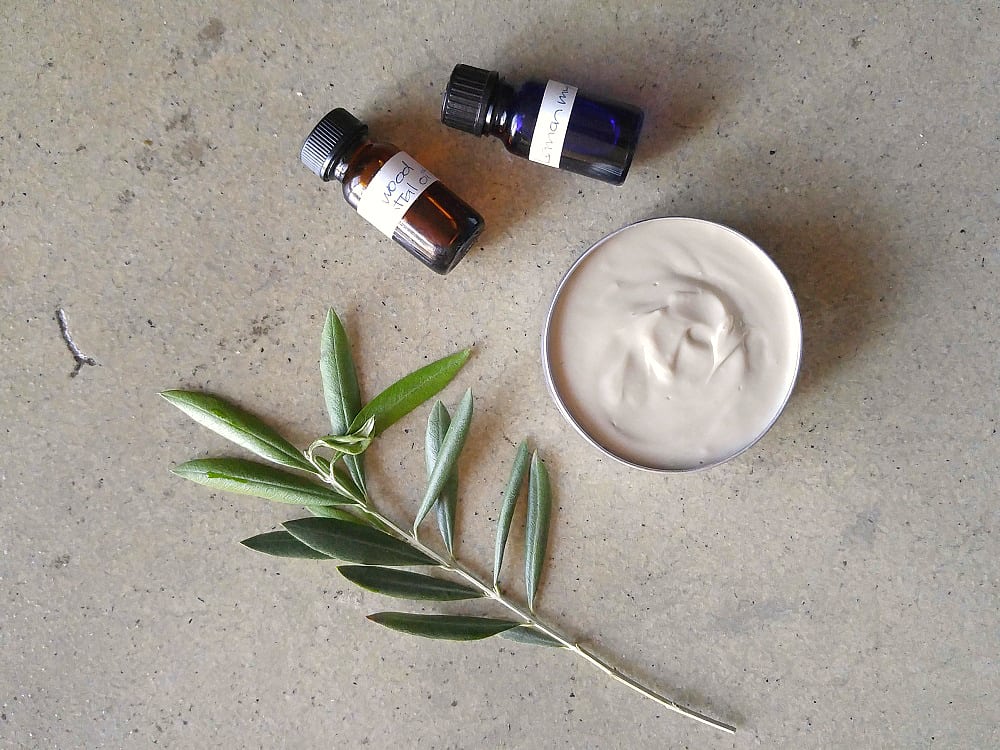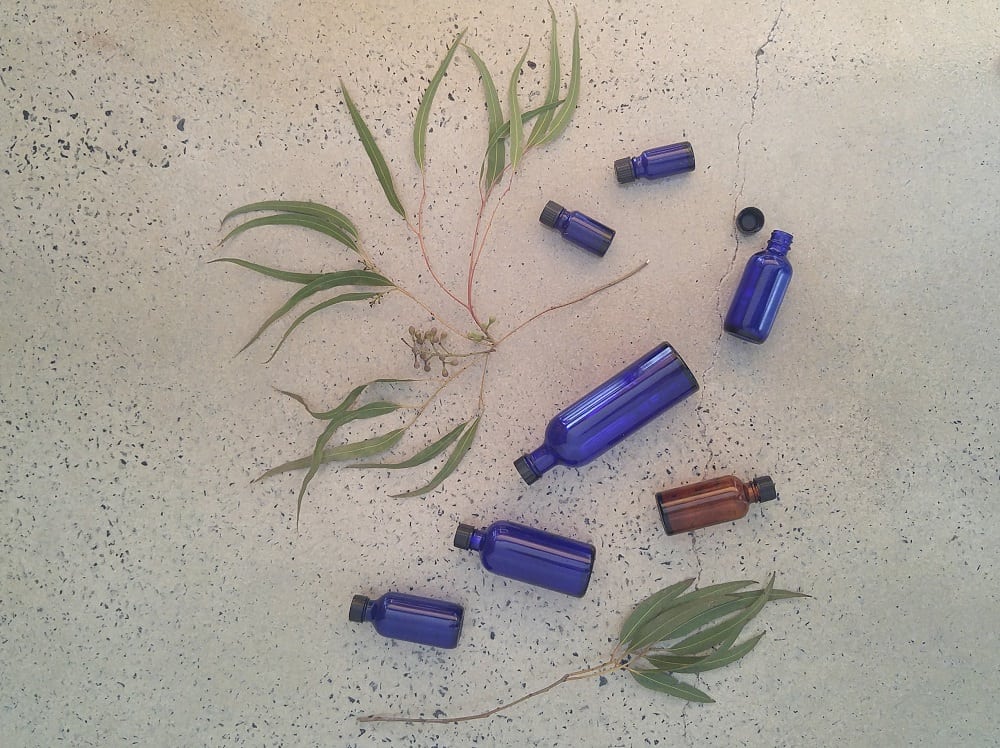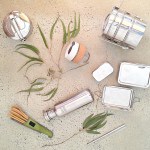Plastic Free {Bicarb Free} DIY Deodorant – for Sensitive Skin
I love my homemade deodorant. I first tried it back in 2012 when I was still a little skeptical about DIY concoctions (if I’m honest, I thought they were just for hippies). What made me convert?
The fact it actually worked.
That’s all we want from a deodorant, really. Sure, we don’t want chemicals and excess packaging – but it has to work, right?! There are plenty of natural deodorants on the market, but most are very expensive, don’t smell great and don’t actually work against body odour very effectively, either.
Plus very few have completely plastic-free packaging.
The deodorant I’ve been using since 2012 is a super simple recipe, and all the ingredients are edible (except the essential oil). There’s no heating or melting involved, just a little mixing, which suits my laziness when it comes to these things.
The ingredients are 1 tbsp bicarb, 4 tbsp cornflour (or arrowroot / tapioca flour) and 2-3 tbsp coconut oil. The coconut oil depends on the ambient temperature – you’ll need less in summer and more in winter. You want a paste. Mix in a jar and add a few drops of your favourite essential oil. To apply, get a small amount on your fingertips and rub in. (You can find the recipe here.)
This recipe has been serving me well for 4 years, but bicarb can be a skin irritant for some. It’s fine for me, but my husband reacts to it. I tried changing the ratio from 1:4 to 1:6 and even 1:8 bicarb:flour (note – the more you dilute it, the less effective it is) but the issue was the same. His skin became red, inflamed and sore and it took a few months for it to settle back down again.
Ever since then I’ve said I’ll experiment with a DIY non-bicarb deodorant. I don’t move very fast it seems!
But the good news is I have finally kept my word and made a bicarb free deodorant. Not only that, but I (and my husband) have tested it and can confirm that a) it works (hurrah!) and b) there have been no adverse skin reactions. Phew! I can also buy all the ingredients completely packaging-free.
For anyone else out there who struggles with super sensitive skin and cannot use bicarb deodorants, this recipe is for you. Give it a go.
It’s not quite as simple as just mixing some ingredients in a jar but it’s really not that much harder, promise. There’s some melting involved. Nothing complex – I like to keep things as simple as I can!

Bicarb free DIY deodorant.
TIP: I would also add: it’s not quite as effective as the bicarb version I use, and it works best applied to clean skin. Whilst the bicarb one can mask smells if reapplied, this one won’t!
Bicarb Free DIY Deodorant: Recipe
Ingredients:
1.5 tbsp grated beeswax
1 tbsp shea butter
4 tbsp coconut oil
4 tsp white kaolin clay
8 drops tea tree essential oil
8 drops cedarwood essential oil
10 drops lemon myrtle essential oil
A note about the ingredients:
Beeswax: beeswax is solid at room temperature (it melts at 62°C) so helps make the mix firmer. I used beeswax as it’s really local (my neighbour who lives 4 doors away produced this). The only other solid subsititue I can think of would be cacao butter so maybe next time I’ll give this a go as it would be a great alternative for vegans.
Shea butter: shea butter melts at 38°C so is more solid than coconut oil. It’s very moisturising and is thought be anti-inflammatory – which is good news for sensitive skin.
Coconut oil: this is a soft oil that melts at 25°C. It helps keep the deodorant soft so it can be rubbed into the skin. Coconut oil is also thought to have anti-bacterial properties.
Kaolin clay: kaolin clay is a white clay (bentonite clay has similar properties) that replaces bicarb and does a similar job. It absorbs liquid and neutralises bad smells. Clumping kitty litter is actually made of bentonite clay! There are other types of clay available but these are more expensive. I’ve heard that green clay is the most absorbant of them all so at some stage I’d like to try this… it’s in the queue ; )
Essential oils: I’m lucky enough to be able to buy refills (packaging free) so I have some flexibility with my choice. I chose tea tree oil as it is anti-bacterial and cedarwood as it is anti-inflammatory. Both also have strong smells and are often used in commercial natural deodorant recipes. I find both scents quite overpowering and not hugely pleasant so I used lemon myrtle (which I love!) to mask them. Lemon myrtle is an Australian bush scent with the most amazing smell! If you have limited choice, go for a single oil and choose one that you can use elsewhere. Tree tree oil is affordable, available in larger sizes (meaning less packaging overall) and great for cleaning too. (When choosing essential oils, it is important to read up on the properties, particularly if you are pregnant.)

Ingredients for making bicarb-free deodorant (for sensitive skin).
Method:
Heat some water in a pan on the stove, and place a glass bowl over the pan. You don’t want to heat the oils directly as you’ll damage them. Add the beeswax to the bowl and stir until melted (I used a metal spoon as it’s easier to clean than wood).
Add the coconut oil and continue to melt, stirring occasionally. Once both are melted, add the shea butter and remove the bowl from the heat.
The shea butter should melt with the heat of the other two ingredients. You can place back on the heat if it needs some help but be careful of overheating shea butter as it can turn grainy. Stir to aid the melting process and to combine.
Add the clay 1 tsp at a time and whisk to incorporate. Once all 4 tsp have been added, leave to cool, whisking occasionally. It will begin to thicken after only a few minutes (less if your room is cold). Once you notice the thickening and there is no head radiating from the mix, add your essential oils to the mix and whisk in. If you add them when it’s still hot, you will lose all their beneficial properties!

Final product: bicarb free DIY deodorant.
Pour into a shallow jar with a wide neck or a tin, and leave to set. It will set into a paste that feels tacky and is easy to scoop with your fingers. (If you live in a very cold climate and find it too hard, you may like to add more coconut oil or less beeswax next time to get the right consistency, but it will soften with the warmth of your skin.)
Store with the lid on in a dark place. To apply, take a small amount with your fingertips and rub into your skin. will keep for ages.
Now tell me…are you going to make it?! If yes, I want to hear what you think! If not, why not? Have you ever tried making DIY deodorant before? What ingredients did you use and what success did you have (or not have)? What about other DIY skincare products – are you a fan or do you tend to put them in the “too-hard” basket? What are your simplest solutions to bathroom essentials? I love hearing your thoughts so please leave me a comment below!
[leadpages_leadbox leadbox_id=1429a0746639c5] [/leadpages_leadbox]






Candelilla wax is usually used to veganize beeswax recipes.
I’ve had great luck with Angry Chicken’s deodorant recipes in the past, but have been using conventional deos for the past year. I was hoping I could re-use my conventional deodorant tubes, but it may or may not work. Your latest recipe looks great!
Thanks for the vegan wax tip Rebecca! The lady I buy my ingredients from also uses a vegetable wax that’s vegan, but I need to check it’s not palm-oil based. I’ll look out for this one!
So many people say great things about Angry Chicken’s deodorant! I looked at the ingredients and it contains bicarb, so no good for those with sensitive skin. My husband was buying deodorant in glass deodorant bottles (the ones with the roll-ball top) for a while and we have quite a few stored. They are refillable but need a liquid deodorant, not a cream or paste. So I’ll have to figure out another recipe sometime to use those bottles! What sort do you have – the same or those ones that push the deodorant up (in a cream format)?
Oh, and thanks! Let me know if you try it and how you get on!
Thanks so much for sharing – I too react to the bi-carb, but have never tried making my own. I loved the photos in this post :)
My pleasure Jo! Let me know how you go if you make it! I want to try other recipes in the future, but it’s at the bottom of my rather big to-do list! One day ; )
Oh and thanks! : )
Happy sensitive pits! I must try this; my other batch is nearly done and I’d like to try a different recipe to see how it compares.
Nadine, that made me smile! Do you have a bicarb-free deodorant recipe too? Are you happy to share so that I can compare notes? ; )
Hi Lindsay, what sort of places have you found your Shea butter and kaolin clay? I have not seen them package free or without plastic around here. I also saw in your first recipe that you found plastic free cornflour, I’m still looking for this too!
Hi Tammy, there is a local lady that makes her own beauty products, soaps etc that I’ve been buying from for ages. She sold me the other ingredients – she buys in bulk as she makes so much! She has all kinds of things! I would say try to find a local beauty product maker/soap maker and ask them. Although I have seen on Instagram that it is possible to find clay in bulk (although I think the store was in the US) – not something I’ve seen here yet though.
I can’t remember where the original cornflour was from, I think it was in a box? (I bought it in 2012 – I don’t use for cooking!) Now I use arrowroot/tapioca as it does the same job and is easier to find in bulk. Most bulk stores here have it.
I hope that helps!
Another great deodorant is simply to use a lime – cut a piece off and rub under arms – works a treat. Keep lime in fridge to slice more & use the next day! Caroline
Hi Caroline, I’ve heard that said about lemons to but I must confess – I’ve never tried! I will have to give it a go someday. Thanks for sharing! : )
If you look at what causes the odour it’s easy to find many solutions to the problem.
Primarily, odour is caused by bacteria ‘growing’ in your sweat thus anything that is anti bacterial can work. I currently use diluted Apple Cider Vinegar with essential oils (to mask the vinegar smell) in a small spray bottle which I reuse.
Hi Bella, that’s true, but the ingredients don’t have to be anti-bacterial. For example, both bicarb and clay work by absorbing sweat and masking odour, not by being antibacterial.
Lots of solutions :)
Hi Bella I currently use a vodka and acv and essential oil recipe as I found a few different paste deodorants didn’t cut it for me. My only problem is that I worry I smell like vinegar all the time – do you find you have to top it up with essential oils every so often to improve the smell? Thanks
Hi,
Thank you for sharing this recipe. I will try this one as I am interested of the result using this DIY deodorant. This will be my first time making and using DIY deodorant.
My pleasure, Wendy :) As I mentioned, I personally find the bicarb one to be slightly more effective on me, although this one works on my husband for hours. If you don’t like one, try the other – and do let me know how you get on!
Great recipe, thanks!
I think the bicarb not only absorbs, it also creates an environment that’s too basic for bacteria to survive. Win-win, if you can use it. Does anyone have a reliable online source for essential oils? Friend recommended doterra (US), but their business model feels too much like Tupperware …
Hi Corinna, my pleasure. I get my essential oils refilled from a local place so I don’t need to buy online. I’m not sure, although I don’t love multi-level marketing, which DoTerra is, so I wouldn’t recommend it. Find a local business worthy of your support, would be my recommendation :)
Got to try this. I’ve used bicarb deodorant and it worked well, but I found it bleached my t-shirts over time, or had an effect on the colour under the armpits! Not cool :(
Thanks for this! I’ve just made a batch. I too had redness and irritation from the bicarb recipe so hoping this will solve my problems! I find the home made deodorant worked much better than the store bought ones anyway,